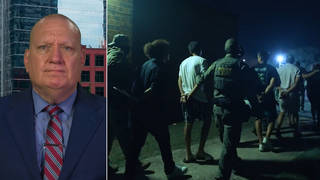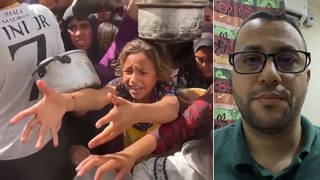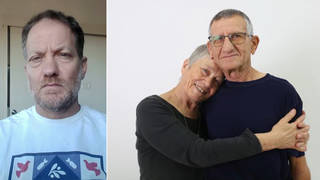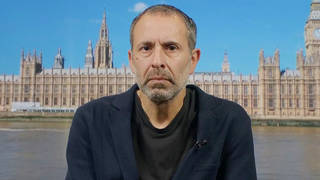
Guests
- Reed Brodycounsel and spokesperson for Human Rights Watch. He has written several reports for Human Rights Watch on prisoner mistreatment in the war on terror, including a 2011 report which called for a criminal investigation of senior George W. Bush administration officials.
Graphic new details of the post-9/11 U.S. torture program came to light Tuesday when the Senate Intelligence Committee released a 500-page summary of its investigation into the CIA with key parts redacted. The report concludes that the intelligence agency failed to disrupt a single plot despite torturing al-Qaeda and other captives in secret prisons worldwide between 2002 and 2006, and details a list of torture methods used on prisoners, including waterboarding, sexual threats with broomsticks, and medically unnecessary “rectal feeding.” The report also confirms the CIA ran black sites in Afghanistan, Lithuania, Romania, Poland, Thailand, and a secret site on the Guantánamo Naval Base known as Strawberry Fields. So far no one involved in the CIA interrogation program has been charged with a crime except the whistleblower John Kiriakou. In 2007, he became the first person with direct knowledge of the program to publicly reveal its existence. He is now serving a 30-month sentence. We speak with Reed Brody, counsel and spokesperson for Human Rights Watch, who has written several reports on prisoner mistreatment in the war on terror, including a 2011 report which called for a criminal investigation of senior Bush administration officials.
Transcript
AMY GOODMAN: Graphic new details of the post-9/11 U.S. torture program came to light Tuesday when the Senate Intelligence Committee released a 500-page summary of its investigation into the CIA. The report concluded the intelligence agency failed to disrupt a single plot despite torturing al-Qaeda and other captives in secret prisons worldwide between 2002 and 2006. Senator Dianne Feinstein, chair of the Senate Intelligence Committee, outlined the report’s key findings.
SEN. DIANNE FEINSTEIN: First, the CIA’s enhanced interrogation techniques were not an effective way to gather intelligence information. Second, the CIA provided extensive amounts of inaccurate information about the operation of the program and its effectiveness to the White House, the Department of Justice, Congress, the CIA inspector general, the media and the American public. Third, CIA’s management of the program was inadequate and deeply flawed. And fourth, the CIA program was far more brutal than people were led to believe.
AMY GOODMAN: The Senate report details a list of torture methods used on prisoners—waterboarding, sexual threats with broomsticks, medically unnecessary “rectal feeding.” In one case, a prisoner had his entire “lunch tray” of hummus, pasta and nuts puréed and administered by enema. Prisoners were threatened with buzzing power drills. Some captives were deprived of sleep for up to 180 hours, at times with their hands shackled above their heads.
Speaking on the floor of the Senate Tuesday, Senator Feinstein discussed the death of Gul Rahman at a CIA black site north of Kabul, Afghanistan, known as the Salt Pit.
SEN. DIANNE FEINSTEIN: CIA placed a junior officer, with no relevant experience, in charge of the site. In November 2002, an otherwise healthy detainee, who was being held mostly nude and chained to a concrete floor, died at the facility from what is believed to have been hypothermia. In interviews conducted in 2003 by the CIA officer of the inspector general, CIA’s leadership acknowledged that they had little or no awareness of operations at this specific CIA detention site.
AMY GOODMAN: Senator Feinstein discussing the death of Gul Rahman. The Senate report also reveals Rahman was only detained due to mistaken identity.
In another case, a detainee named Abu Hudhaifa was subjected to “ice water baths” and 66 hours of standing sleep deprivation before being released because the CIA discovered he was likely not the person he was believed to be.
According to the Senate report, the CIA ran black sites in Afghanistan and Lithuania, Romania, Poland, Thailand, and a secret site at the Guantánamo Naval Base known as Strawberry Fields.
The Senate report released Tuesday is just the summary of a much longer investigation into CIA’s torture practices. Key parts of the summary were redacted. The names of two psychologists who helped the CIA create the torture program are not included in the summary. The report does detail that the psychologists, whose names are James Mitchell and Bruce Jessen, received an $81 million contract from the CIA.
So far, no one involved in the CIA interrogation program has been charged with a crime—with one exception: the whistleblower John Kiriakou. In 2007, he became the first person with direct knowledge of the program to publicly reveal its existence. He is currently serving a 30-month sentence.
For more on the Senate torture report, we’re joined by Reed Brody, counsel and spokesperson for Human Rights Watch. He’s written several reports for Human Rights Watch on prisoner mistreatment in the war on terror, including a 2011 report which called for a criminal investigation of senior Bush administration officials.
Reed, since I’m speaking to you from Lima, Peru, where the U.N. climate summit is happening, and you’re in New York, and there’s a satellite delay, if you could just lay out the most critical points that have come out in this, again, just the summary, not the actual thousands of pages that are still classified, but the remarkable revelations in this summary that has been released by the Senate Intelligence Committee?
REED BRODY: Sure, Amy. As you say, the first thing that really jumps out is just the sheer pervasiveness of the brutality. I mean, even those of us who have been looking at this for the last 10 years, as one of my colleagues said, may be not surprised, but shocked.
You know, you described the rectal feeding, the rectal hydration. You know, this was not just one prisoner, this was a number of prisoners. And they were used, according to the CIA documents, as a means of behavior control. I mean, this is, you know, an IV infusion placed up somebody’s rectum, and the person is in a forward-facing position, their head lower than their torso, at which point you put in a rectal tube with an IV. The flow will regulate, sloshing up the large intestines. You put up the tube as large as you can, then you open the IV wide. No need to squeeze the bag, let gravity do the work. And this was not—you know, this is rape. This is the CIA discussing in emails and documents the methods they are using to rape detainees.
A detainee who died in the Salt Pit in Afghanistan, who was partially nude and chained to a concrete floor, who died from suspected hypothermia; at least three detainees were threatened with harm to their families, threats to the children of detainees, threats to sexually abuse the mother of a detainee; a detainee told that he would never be allowed to leave alive; detainees placed in ice water baths; people shackled in dark cells, called by—the CIA’s own people referred to it as a “dungeon”—I mean, this is medieval stuff. And, you know, it really—it really—I have say, it’s really shocking, even for me.
As you mentioned, this was a dysfunctional program. The interrogation program was essentially outsourced to these two psychologists, who you mentioned. And neither psychologist had any experience as an interrogator. They had no specialized knowledge of al-Qaeda, no background in counterterrorism or any relevant linguistic or cultural information. And as you pointed out, they received $81 million. And these contractors made up 85 percent—or their company that they created and other contractors made up 85 percent of the workforce for these detainee operations.
Now, at the same time that it was run amok, there was a culture—and this is important to understand—of just, you know, let them loose. On a number of occasions, there were complaints. There were—things went up to headquarters. And the word that came back was: “Look, we’d rather be safe than sorry.” And in one case, no action was taken against a CIA officer for wrongful detention because, quote, “[t]he Director strongly believes that mistakes should be expected in a business filled with uncertainty. … [T]he director believes the [scale tips] decisively in favor of accepting mistakes that over connect the dots [against those that] under connect them.” Even in the case of the death from suspected hypothermia that we talked about, headquarters decided not to take action because they were “motivated to extract any and all operational information.”
You pointed out, I think, probably the key thing being discussed in Washington today is the conclusion that no actionable intelligence that could not have been garnered by other means were extracted through this program. And the committee went through 20 incidents in which the CIA claimed to have garnered actionable intelligence that was used to capture people or to foil plots. And in each of those 20 incidents, the committee found either that the intelligence already existed, that it wasn’t used, or that the plot in fact didn’t exist. And people particularly focus on the capture of Osama bin Laden and the identification of the courier who led the U.S. to Osama bin Laden. And the committee found that the vast majority of the intelligence about the Qaeda courier, quote, “was originally acquired from sources unrelated to the CIA’s detention and interrogation program, and the most accurate information acquired from a CIA detainee was provided prior to the CIA subjecting the detainee to … enhanced interrogation techniques.”
Another thing we see here constantly is the desire to evade the law. You referred to, and Dianne Feinstein, in what I found to be a remarkable speech on the Senate floor, referred to the lies. But there are a lot of little tidbits that we find in this report. For instance, you mentioned there was, in addition to the black sites in foreign countries, there was a black site at Guantánamo. But in 2004, the Supreme Court in the Hamdan ruling basically said the Constitution applies in Guantánamo. And at that point, the detainees who were in Guantánamo were shipped out of Guantánamo—and this is the CIA detainees, of course—and they were sent to Morocco. And actually, what’s interesting tidbit in the report is that they were actually placed in a Moroccan jail, as opposed to the other countries where they were placed in CIA facilities. And the problem was that they heard—they were so close to the Moroccan prisoners that they could hear the Moroccan prisoners screaming.
In the other cases, in Thailand, Afghanistan, Poland, Romania, the CIA detention centers were far away from—they were CIA detention centers. What is interesting in this report, too, about those centers is the kind of the diplomatic cost of having CIA detention centers in another country. Often, the ambassadors to those countries were not informed or were only informed after the deal was done. In order to basically buy the cooperation of these countries, the U.S. had to offer them wish lists of what they wanted. In one very interesting note in the report—and it shows the kind of the perverse effect of having a CIA detention center—the secretary of state in 2004 ordered a U.S. ambassador in an unnamed country to démarche the country to ask that that country provide for its prisons full access to the International Committee of the Red Cross. But, of course, the problem was, at the same time, the U.S. had prisoners in that country who it was keeping secret and, obviously, not available to the Red Cross.
Final and probably most important point is, I guess, what is not in this report. This report, you know, deals with one aspect of one part of the detainee mistreatment in the war on terror. It deals with the CIA prisoners held in black sites. It does not, for instance, deal with renditions by the CIA. So there’s no mention in here of the CIA sending prisoners to places like Syria, under Bashar al-Assad, where people like Maher Arar, who has been on your show several times, was tortured. It does not talk about people being sent to Libya, under Muammar Gaddafi’s intelligence agencies, where they were tortured. It does not talk about people being sent to Egypt. And it doesn’t talk about what the Pentagon was doing. It doesn’t talk about the programs approved by Donald Rumsfeld.
And probably more importantly, by focusing everything on the CIA, it tends to kind of let off the hook all those people above who authorized these programs. So, we know, and from President Bush’s own memoirs, that he authorized waterboarding. Vice President Dick Cheney, Attorney General John Ashcroft, White House counsel Alberto Gonzales, these are all people who signed off on the authorization on these techniques, not to mention the lawyers, people like John Yoo and Jay Bybee, who gave the legal authorization for this.
Earlier, you had President Obama’s remarks, in which he said that it was important that this report be made public so that, hopefully, we won’t make these mistakes again. These aren’t mistakes. These are crimes. And, you know, Dianne Feinstein, in her Senate remarks, referred to the U.N. Convention Against Torture, which says that torture can never be justified under any circumstances. Well, that convention says something else. It says that torture must be prosecuted, that when someone is alleged to have committed torture, the state concerned must refer that case to their competent authorities for the purpose of prosecution.
What assurance do we have that this is not going to happen again? You know, it’s not enough, again, to say, “Well, we tortured some folks, this was a bad policy choice, I’m going to put a stop to the torture.” You know, it is not a policy choice, again. It is a crime. And there needs to be—if this is really going to be—if there are really going to be any deterrence for this not happening again, there needs to be prosecutions. And it’s wonderful—you know, you’ve talked about Human Rights Watch’s work around the world. Human rights organizations regularly, when countries commit torture, when individuals commit torture, we call on those countries to hold the abusers to account. And that has to be the same thing for the United States. We believe, as you mentioned—and we’re not the only ones, the United Nations has said the same, Amnesty International has said the same—that there is a case to answer for senior U.S. leaders on charges of torture, for the things in this report and for the wider authorizations that they gave for torture and war crimes to be committed.
AMY GOODMAN: Reed Brody, I want to thank you very much for being with us. Reed Brody is counsel and spokesperson for Human Rights Watch. He’s written several reports for Human Rights Watch on prisoner mistreatment in the war on terror. And we will link to the latest executive summary of the Senate report that has been released. And, of course, we will be bringing you more on this in the days to come.
This is Democracy Now!, democracynow.org, The War and Peace Report. We’re broadcasting from Lima, Peru, where the U.N. climate summit is taking place. When we come back, we’ll be joined by one of the leading environmentalists in the world, Nnimmo Bassey of Nigeria. Stay with us.












Media Options